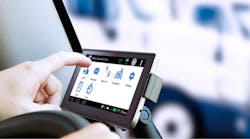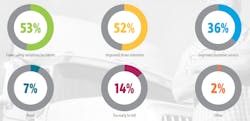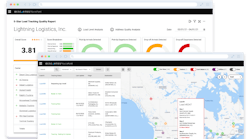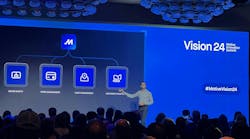While a record number of fleets and trucking companies have adopted telematics technology and fleet management systems to some degree, a new study finds—you can thank the electronic logging device (ELD) mandate for much of the uptick—many of those organizations aren't what you'd call "power users."
"The vast majority of transportation companies are not using their [telematics] system to its full potential," contends fleet management systems provider Teletrac Navman in the study, 2018 Telematics Benchmark Report. Return on investment from ELDs hinges on access to operations data and how well the business uses that information to improve efficiency, the company noted.
Teletrac Navman surveyed nearly 1,300 U.S. fleet operations and more broadly some 2,400 fleets around the globe, and this morning released the U.S. edition of its findings. The effort included private, for-hire, government, and other fleets from small to large.
In January prior to the April 1 full enforcement deadline for ELDs, about a third of U.S. fleets were still using paper logs. Around one out of six continued on with their older automatic on-board recording devices, or AOBRDs, the predecessor technology to ELDs that triggered an extension where the company doesn't have to be using the newer devices until December 2019—as long as AOBRDs were in place by Dec. 17, 2017, before the ELD mandate took effect.
Cost factors
In terms of costs, about half of fleet respondents said payroll is their biggest expense. Fuel was the second-largest expense for more than one-third of fleets in the survey, and equipment and vehicle maintenance followed very closely behind. New vehicle and equipment purchases and fleet insurance costs registered significantly as well, but trailed those others.
Notably, Teletrac Navman found that while costs like fuel and insurance ranked in the top five expenses fleets cited, relatively few respondents said they're using telematics to reduce those costs. For instance, only 29% indicated they use their fleet management systems to track and potentially lower fuel use.
The study provided an example from Fontana, CA-based carrier Pointdirect Transport, Inc., which was able to cut its insurance premiums by using telematics to track vehicle info. Teletrac Navman heard from Adolfo De La Herran, president of Pointdirect, who said the company "just went through our insurance renewal, and that year-over-year improvement got us a huge reduction in insurance cost."
Mobile tech on the rise
Along with record use of telematics and fleet management systems that has come with ELDs, Teletrac Navman also found high mobile device adoption rates. More than three out of four—76%—of survey respondents said they either offer mobile devices for drivers outright (63%), plan to offer mobile devices within the next year (4%), or have a "BYOD" setup where drivers can use their own mobile devices with company telematics systems (9%).
While fleets with telematics systems can potentially monitor driver behavior, 43% of those that have the systems do not. And among fleets that are monitoring driver behavior, 43% said they don't reward drivers for doing things right—possibly indicating they're only focusing on adverse driving.
And that may be to their own detriment. Survey respondents reported a number of benefits from rewarding drivers for better performance, including fewer safety violations, fewer accidents, higher retention rates, and better customer service.
The takeaway on these points: "Businesses need to focus on the more sophisticated uses of GPS fleet tracking such as route optimization and driver behavior to stay relevant," Teletracs Navman surmised.
Boom times
As a backdrop for all this, the strong U.S. economy is a double-edged sword—businesses including fleets are optimistic about future growth, but extremely low unemployment rates are making the worsening driver shortage even more difficult to fill.
Getting and keeping the best drivers "are among the top 2018 business goals" for fleets, Teletrac Navman noted. The No. 1 way to do that is through employee referrals, and more than half of fleet respondents said they use online job boards. But social media sites like LinkedIn and Twitter are a growing method as well.
Call it a sign of the times: social media sites (used by 34% of fleets) surpassed corporate websites (28%) and easily beat print media and trade publications (23%) in driver recruitment efforts. All told, the study mapped 13 different avenues fleets are using to find drivers.
Fleets also are sweetening the deal for drivers as they compete for talent. More than half—58%—of participating fleets said they're raising driver pay, and more than a third (36%) are offering richer benefits packages. Getting back to driver behavior monitoring, 57% of fleets said they reward drivers based on performance, and more than half of those claimed doing so boosts retention.
Over one in four fleets, 27%, said they're offering drivers more flexible work arrangements. And 10% of respondents are investing in health and wellness programs, the study found.
However, in yet another yin-yang scenario, Teletrac Navman noted that increased technology adoption can help in recruiting younger drivers—a point many others have made as well. But a majority of fleets, 58%, said they're through with any additional technology implementation this year.
"The recent ELD mandate may be giving companies tech fatigue," Teletrac Navman speculated.
As far as what they are investing in other than their driver workforces, survey respondents even more often said they're spending money to upgrade (41%) and expand (37%) their fleets this year.
For future growth, fleets are seeing the most opportunities in short-haul trucking, with long-haul trucking/ freight delivery a close second. Small-package delivery and fuel-hauling trailed considerably in growth opportunity, according to fleet respondents, and showed declines from the prior year.







